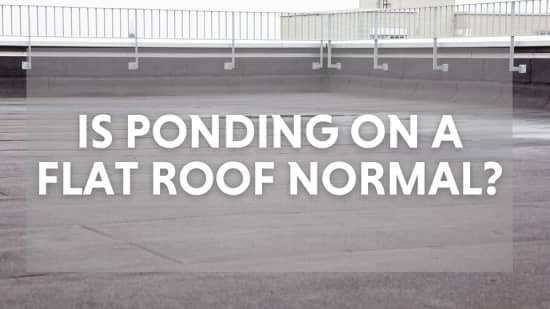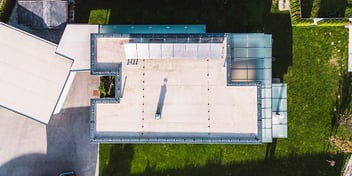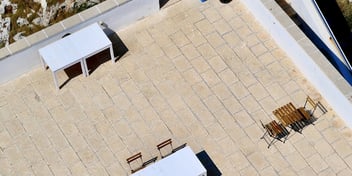- Home »
- Learningcenter »
- Is ponding on a flat roof normal
Is Ponding Water On A Flat Roof Normal? - Roof Drainage Tips

Standing water on your roof is never something you want to see - and if you find yourself with ponding on your roof, you may be asking yourself: Is this normal? The answer isn't always as simple as yes or no, but let's talk more about what ponding is, the potential causes, and what to do when you see it.
What Is Ponding?
Ponding is when water sits on a flat roof for more than 48 hours. This can happen for several reasons, like the the roof's drainage system not being designed properly for the structure of the roof. Because ponding by definition is a large amount of water, it becomes problematic since it's unlikely to evaporate and the water has nowhere to drain. These large puddles can cause significant problems for a flat roofing system, and since the water has to drain somewhere the place it usually ends up going is down.
What Causes Ponding?
Uneven Roof Slope
Of course, when your flat roof is initially engineered and designed, if it's done correctly your roof will be sloped so that water and debris will flow towards a roof drain. Flat roofs have thick layers of insulation to keep heat in in the winter and cool air in in the summer. Proper insulation is critical, because homes and buildings lose the majority of their energy from the roof.
Insulation however, is made from a highly malleable material, so problems can start when it becomes crushed from heavy foot traffic, or snow that piled up in colder climates. This causes depressions in the roofs surface, which is a perfect recipe for standing water. It will pool in these lower areas, especially during heavy rains, and they are too deep to evaporate quickly, which can cause serious problems if it's not addressed in a timely manner.
Improper Roof Drainage
Flat roofs need to have proper drainage in order to remain dry, and avoid ponding water. Not enough, or improperly installed drains are one of the main causes of ponding water and ultimately, roof damage. A couple of things to note - roofs need to have at least one drain per 10,000 square feet, you need a minimum of two drains per roof area, and drains should be no more than 80 feet apart. Many local building codes in the US will have regulations around this, because of the problems that standing water can cause.
In addition to having enough drains, flat roofs need to have what's called positive roof drainage. This means that the roof is graded enough to help water flow towards the areas with drains to allow it to flow off the roof easily.
Poor Roof Design
There's no escaping this one. If your flat roof wasn't engineered properly with your building design, problems are inevitable. These complications are not always immediately identifiable from the exterior of the building, because they have a lot to do with structural design. If you have ponding water, it's important to hire a roofing contractor that is experienced in designing and installing complex flat roofs. Structural engineers are also important in assessing roof design, because the problem can lie in the joints and beams underneath the roof which can sag over time, causing major roofing issues.
Rubber Roofs With Multiple Layers
When some flat roofs are designed, the first layer is made of tar and gravel, with rubber laid over the top of it. This top rubber layer is extremely hard to get perfectly level, which can lead to issues with roof slope and contribute to ponding water.
Settling Foundation
Another unavoidable problem many flat roofs face is the settling of a buildings foundation over time. This can alter the design of the roof, because it may lower a portion of the building that wasn't initially planned for. How a building will settle on a particular plot of land is impossible to predict, so this issue will typically require a redesign of the existing roofing structure to redirect water.
What Problems Can Ponding Cause?
If you realize you have ponding on your flat roof, it's important to have it assessed as soon as possible. Any water that stagnates on your roof for longer than 48 hours is cause for concern, and there are a variety of problems associated with ponding.
Roof Leaks
As previously mentioned, when water cannot evaporate in a timely manner it needs to go somewhere, and gravity is going to work against you here. Because standing water is heavy, especially large volumes of it, it's going to end up going down. Standing water breaks down roof materials, so if this is a pervasive issue, it's going to cause leaks, it's just a matter of when.
Plant Growth And Debris Build Up
Another common issue with water ponding is vegetation growth and debris build up. As water flows to a particular part of the roof, it carries dirt and debris with it. When your water is ponding instead of being carried out a roof drain, this means you are going to end up with an area where dirt and debris gather, which is never something you want on your roof. Additionally, the moist environment created by ponding is a perfect place for moss, algae, and other plants to make their home. This comes with its own issues, because left unaddressed, plants will root into the roofs surface, and potentially into the insulation and substrate underneath. The roots will also introduce moisture into the structure, which can cause significant mold and mildew if not cleared and repaired quickly.
Sagging Roof Deck
The most extreme and potentially the most dangerous issue that can be caused by ponding is a sagging roof deck, which can lead to a roof collapse. Because roofing materials are designed to be water resistant and not completely waterproof, long term standing water will lead to deterioration. When the material begins to deteriorate, this allows more water to get through and saturate the materials, adding excess weight, and potentially rotting the roof decking underneath. When the roof decking begins to rot, this weakens it, and that combined with the excess weight of standing water is a recipe for disaster.
Is Ponding Normal?
While some small and short term ponding, especially in heavy rains can be normal, any ponding that doesn't evaporate within 48 hours is a cause for concern and should be evaluated by a licensed roofing contractor with experience working with complex flat roofing systems. At Colony Roofers, we specialize in both residential and commercial roofing systems, and have experience working with all types of flat roofing material. We offer free 30 minute inspections, and our team of trusted and dedicated professionals are fully licensed and ready to help you with all of your roofing needs - call us today!
 Call (678) 365-3138
Call (678) 365-3138

